1. What is vegetal chitosan?
Chitosan is a natural biopolymer that is primarily derived from chitin, which is the second most abundant natural polysaccharide after cellulose. Chitin is commonly found in the exoskeletons of crustaceans like crabs, shrimps, and lobsters, as well as in the cell walls of certain fungi like mushroom, aspergillus niger.
Structure and Properties:
- Chemical Structure: Chitosan is obtained by deacetylating chitin. This process involves removing acetyl groups from chitin, resulting in a polymer that has free amine groups.
- Solubility: Unlike chitin, chitosan is soluble in acidic to neutral solutions, making it more versatile for various applications.
- Biocompatibility and Biodegradability: Chitosan is known for its excellent biocompatibility and biodegradability. It’s non-toxic and can be broken down by natural biological processes.

Chitosan, sometimes known as deacetylated chitin, is a natural polycationic linear polysaccharide derived from partial deacetylation of chitin. Chitin is the structural element in the exoskeleton of insects, crustaceans (mainly shrimps and crabs shell), and cell walls of fungi (oyster mushroom, agaricus bisprous and aspergillus niger), and also is the second most abundant natural polysaccharide after cellulose.

Chitosan, a natural polysaccharide prepared of fungal origin, is initially extracted and purified from reliable and abundant food or biotechnological fungal sources such as Agaricus bisporus or Aspergillus niger.
Chitosan is composed of glucosamine sugar units (deacetylated units) and N-acetyl-D-glucosamine units (acetylated units) interconnected by ß→(1.4) type linkages.
Uses and Applications:
- Medical and Pharmaceutical Fields: Due to its biocompatibility and non-toxic nature, chitosan is used in wound healing, drug delivery systems, and as a biomaterial in tissue engineering.
- Water Treatment: Its ability to bind with heavy metals and other contaminants makes it useful in water purification and treatment processes.
- Agriculture: As a natural biostimulant and elicitor, chitosan is used to enhance plant growth and provide resistance against pathogens.
- Food Industry: It’s used as a food additive for its antimicrobial properties, and as an edible film or coating to enhance the shelf life of perishable food products.
- Cosmetics and Personal Care: In this realm, it finds use as a thickener, moisturizer, and film-forming agent, particularly in hair and skin care products.

Chitosan has been widely used in various fields, including wine, pharmaceuticals, dietary supplement, medicine, agriculture, and food industries, due to its biocompatibility, biodegradability, and non-toxicity. In recent years, researchers have investigated the use of vegetal chitosan, which is derived from fungal or plant sources, as a sustainable alternative for use in wine applications.
Variants:
- Traditional Chitosan: Traditionally sourced from marine crustaceans.
- Vegetal Chitosan: Derived from fungal sources, offering an alternative for those seeking non-animal derived products.
In summary, chitosan’s versatility, biodegradability, and non-toxic nature make it a valuable material across various industries, from healthcare to cosmetics. Its ability to be derived from non-animal sources also makes it an appealing option for vegetarian and vegan-friendly products.
2. What are the advantages of vegetal chitosan?
Vegetal chitosan, also known as fungal chitosan or mycelium chitosan, is a type of chitosan derived from the cell walls of fungi (mushroom and aspergillu niger). It has several advantages over traditional chitosan derived from shellfish, including:

- 1. Vegan and vegetarian-friendly: Vegetal chitosan is an excellent alternative for individuals who avoid animal-based products, such as those who follow a vegan or vegetarian lifestyle.
- 2. Allergen-free: Traditional chitosan is derived from shellfish, which can cause allergic reactions in some people. Vegetal chitosan does not contain any shellfish-derived ingredients, making it an allergen-free option.
- 3. Purer: Vegetal chitosan is often considered to be purer than traditional chitosan because it is derived from a single source, whereas traditional chitosan can be contaminated with other shellfish-related substances.
- 4. Better solubility: Vegetal chitosan is more soluble than traditional chitosan, which makes it easier to incorporate into various applications such as cosmetics, pharmaceuticals, wine and food.
- 5. Improved bioavailability: Some studies have suggested that vegetal chitosan has a higher bioavailability compared to traditional chitosan, which means that it can be absorbed and utilized more effectively by the body.
Overall, vegetal chitosan offers several advantages over traditional chitosan, making it an attractive alternative for individuals and industries looking for a vegan, allergen-free, and more effective chitosan source.
3. What are the benefits & functions of vegetal chitosan in animal feed?
Vegetal chitosan, sourced from mushrooms or Aspergillus niger, offers several benefits and functions when used as a feed additive in animal nutrition. Here are the key advantages:
Benefits of Vegetal Chitosan in Animal Feed
- Enhanced Growth: Animals may exhibit improved growth rates due to better feed efficiency and nutrient absorption.

- Improved Gut Health: Vegetal chitosan promotes a healthy gut microbiota balance and better digestion, leading to improved overall health of the animal.

- Enhanced Immune Response: Vegetal chitosan boosts the immune system, helping animals to resist diseases and infections more effectively.

- Reduced Cholesterol Levels: Vegetal Chitosan helps in reducing cholesterol levels in animals, which can result in healthier meat, milk, or eggs for human consumption.

- Detoxification: Binds with toxins and heavy metals, reducing their absorption and effects in animals, thus contributing to safer animal products.

Functions of Vegetal Chitosan in Animal Feed
- Growth Promoter: Vegetal Chitosan acts as a biostimulant that enhances animal growth through improved feed utilization.

- Antimicrobial Agent: Vegetal chitosan exhibits antimicrobial properties that help in controlling pathogenic bacteria and fungi within the animal’s digestive system.

- Immune Modulator: Vegetal chitosan modulates the immune system by enhancing the activity of immune cells and the production of beneficial cytokines.

- Toxin Binder: Vegetal chitosan has function as a binding agent for toxins and heavy metals, reducing their bioavailability in the animal’s digestive system.

- Cholesterol Reducer: Vegetal chitosan acts biochemically to reduce the synthesis or absorption of cholesterol in animals.

These categorized benefits and functions highlight the multifaceted roles that vegetal chitosan can play in animal nutrition, contributing to healthier livestock and better quality animal products.
4. What types of animals benefit from the inclusion of vegetal chitosan as a feed additive?
Vegetal chitosan can be used as a feed additive for a wide range of animals in agriculture and aquaculture. Here are some of the key types of animals that can benefit from the inclusion of vegetal chitosan in their diets:
- Poultry: Chickens, turkeys, and other poultry can benefit from chitosan’s growth-promoting and immune-boosting properties. It helps improve their overall health and productivity.

- Swine: In pigs, chitosan can enhance growth rates, improve feed efficiency, and boost immune function. It can also help reduce the fat content in pork.

- Ruminants: Cattle, sheep, and goats can benefit from chitosan’s ability to improve gut health and nutrient absorption. Its immune-boosting properties are also valuable for maintaining the health of these animals.

- Aquaculture: Fish and shrimp can significantly benefit from chitosan. It helps improve water quality by binding with toxins and enhances the disease resistance of aquatic species.
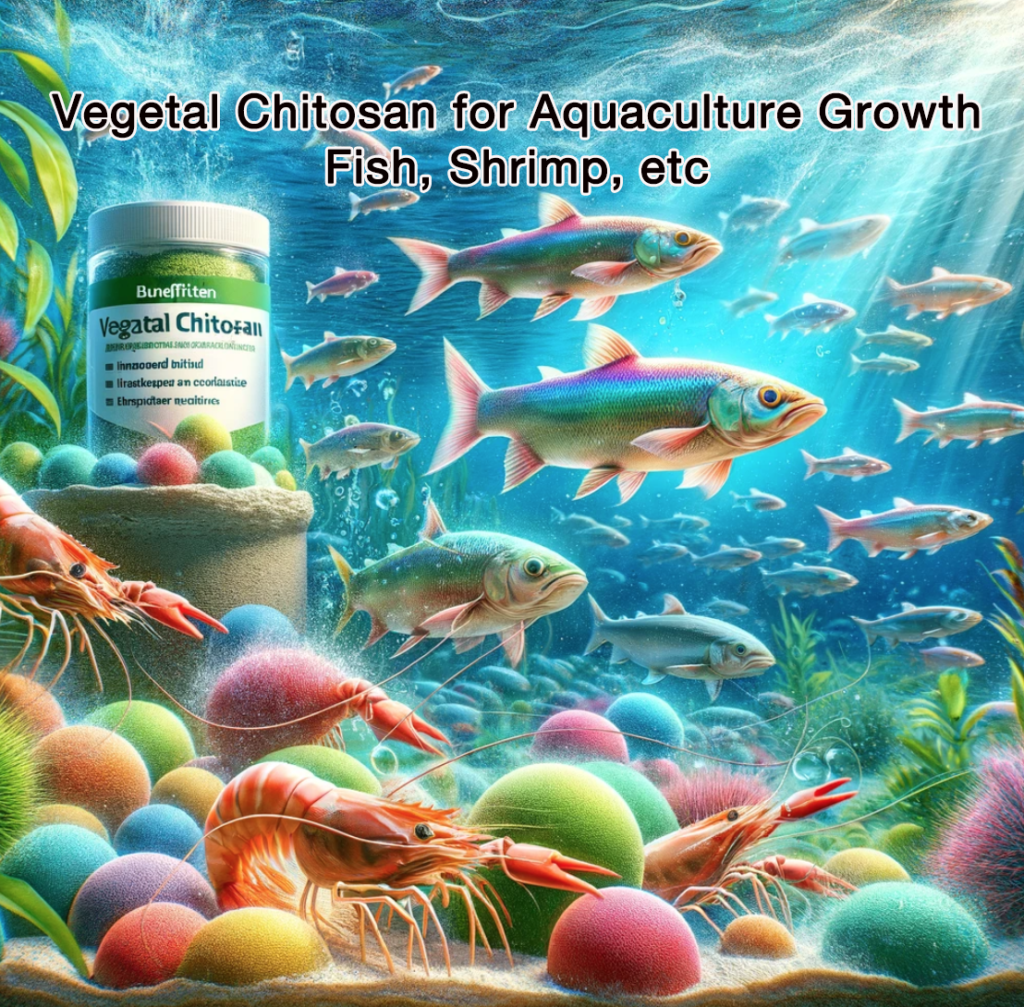
- Pets: Dogs and cats may also benefit from chitosan in their diets. It can contribute to better digestive health, reduced cholesterol levels, and overall enhanced immunity.
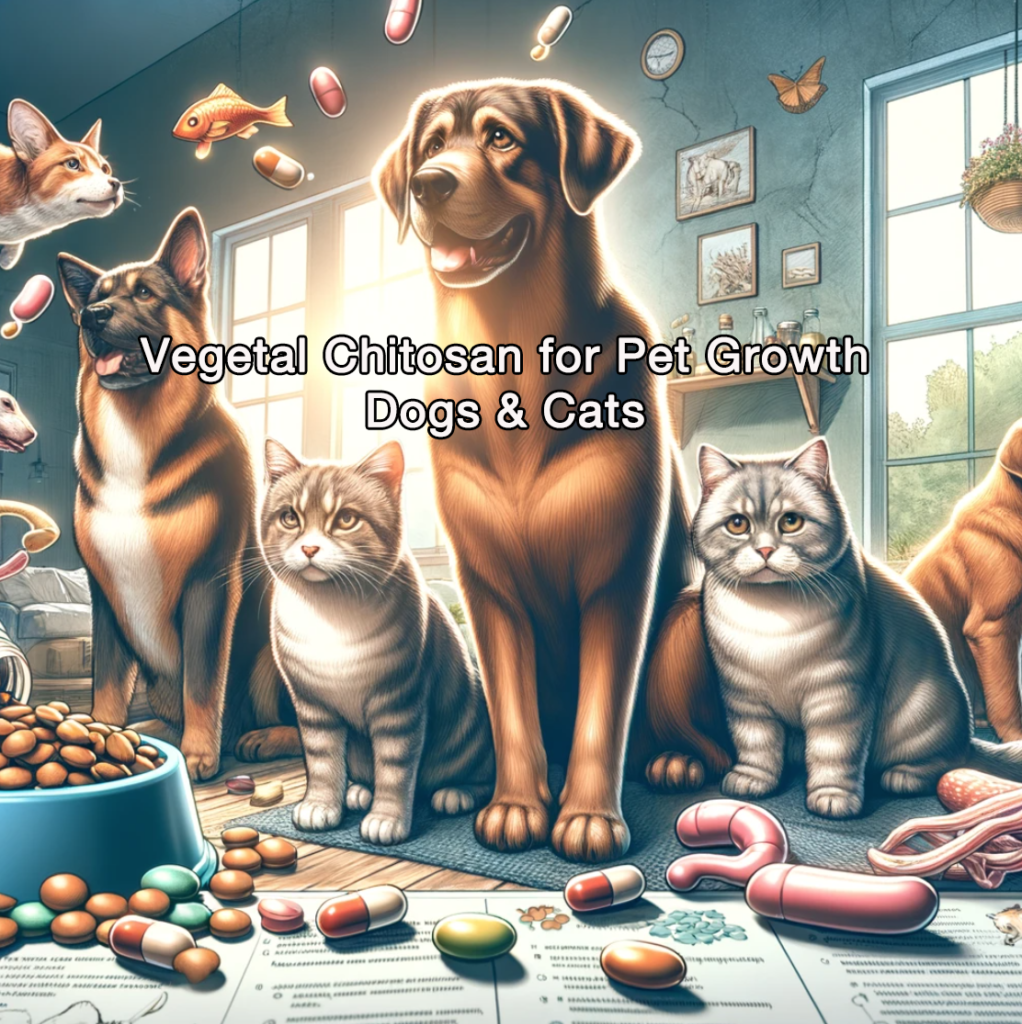
Chitosan is particularly valuable in these applications because of its natural origin and biodegradability, making it a safe and environmentally friendly choice for animal feed additives.
5. What are the forms of vegetal chitosan used in animal feed?
Vegetal chitosan can be incorporated into animal feed in several forms to suit different types of diets and feeding practices.
And the addition ratio of chitosan in animal feed can vary widely depending on the specific form used, the type of animal, the intended health benefits, and the regulatory guidelines in place.
Here are the common forms in which vegetal chitosan is used, along with some general guidelines on the addition ratios for different forms of chitosan and their suitable application areas, and breakdown of which type of vegetal chitosan is suitable for each form:
- Powder: The most common form, chitosan powder is easily mixed with other feed ingredients. It’s versatile for use in both solid and liquid feed formulations.
- Addition Ratio: Typically ranges from 0.1% to 2% of the total feed weight.
- Suitable Chitosan Types: Acid-soluble chitosan with a viscosity range of 20-100cps or 100-500cps is typically used in powder form. Chitosan oligosaccharide may also be suitable for specific applications where rapid absorption is desired.
- Corresponding Applications:
- Growth promotion and immune enhancement in poultry, swine, and ruminants.
- Gut health improvement and toxin binding.
- Incorporation into premixes or complete feeds.

- Pellets: Chitosan can be pelleted along with other feed components. Pellets are particularly popular in livestock and aquaculture feeds as they are easy to handle and distribute.
- Addition Ratio: Generally around 0.5% to 1.5%, mixed with other feed ingredients before pelleting.
- Suitable Chitosan Types: Acid-soluble chitosan with a viscosity range of 100-500cps or 500-1000cps is commonly used for pelleting. Chitosan hydrochloride may also be suitable for specific applications.
- Corresponding Applications:
- Livestock and aquaculture feeds where uniform mixing and controlled release of active ingredients are desired.
- Improved feed efficiency and growth promotion.
- Disease resistance enhancement.

- Flakes: Similar to powder, flakes of chitosan can be mixed into feeds. This form might be preferred for its ease of mixing in certain types of animal diets.
- Addition Ratio: Similar to powder, around 0.1% to 2%.
- Suitable Chitosan Types: Acid-soluble chitosan with various viscosity ranges can be used in flake form, depending on the desired application.
- Corresponding Applications:
- Similar to powder form, suitable for incorporation into feeds where stability and ease of mixing are important.
- May be preferred in certain feed manufacturing processes.
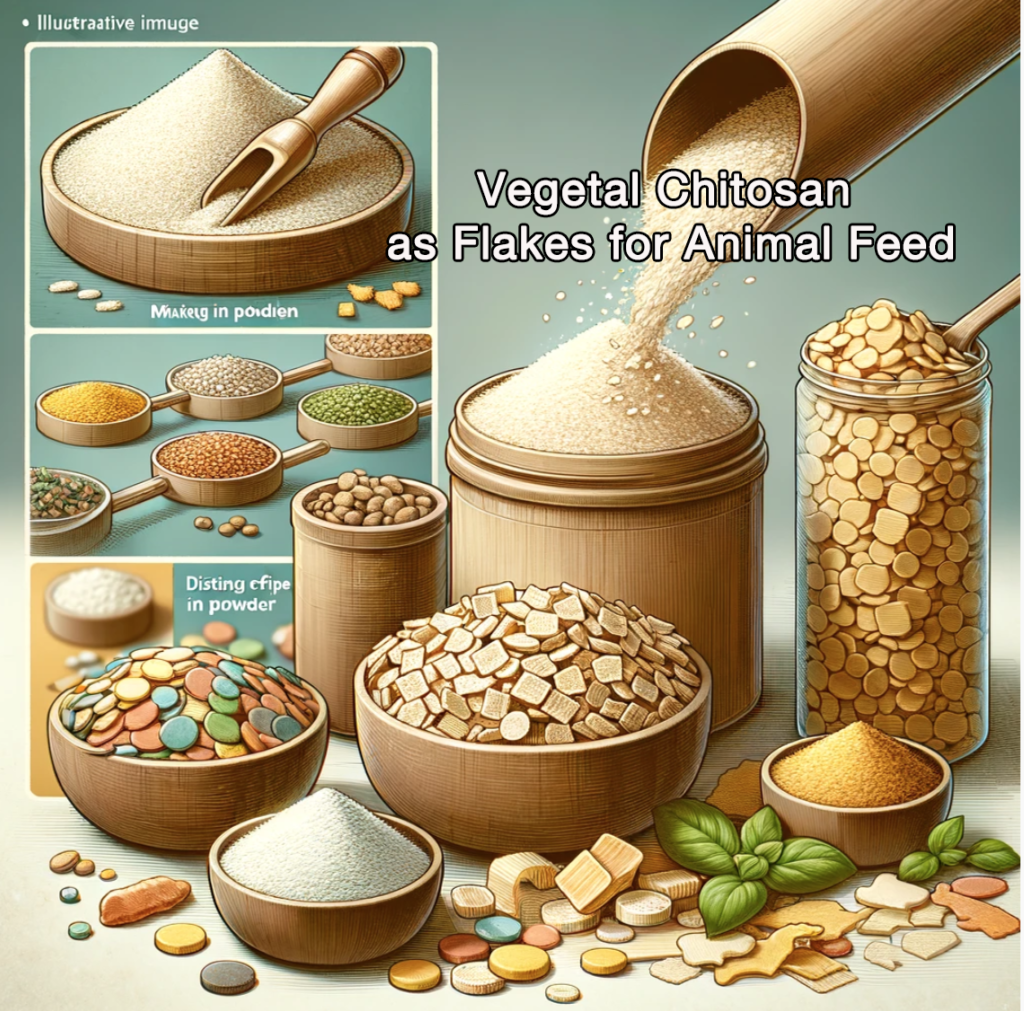
- Liquid Solutions: Chitosan can be dissolved in water to create a liquid feed supplement. This form is beneficial for precise dosage control and is especially useful in aquaculture or for young animals.
- Addition Ratio: Can vary significantly, often used at concentrations of 1% to 5% in the final feed solution.
- Suitable Chitosan Types: Acid-soluble chitosan with a viscosity range of 20-100cps or 100-500cps is commonly used for liquid solutions. Chitosan hydrochloride or carboxymethyl chitosan may also be suitable.
- Corresponding Applications:
- Aquaculture and young animal feeds where liquid feeding systems are employed.
- Disease prevention and immune system enhancement.
- Water quality improvement in aquaculture.
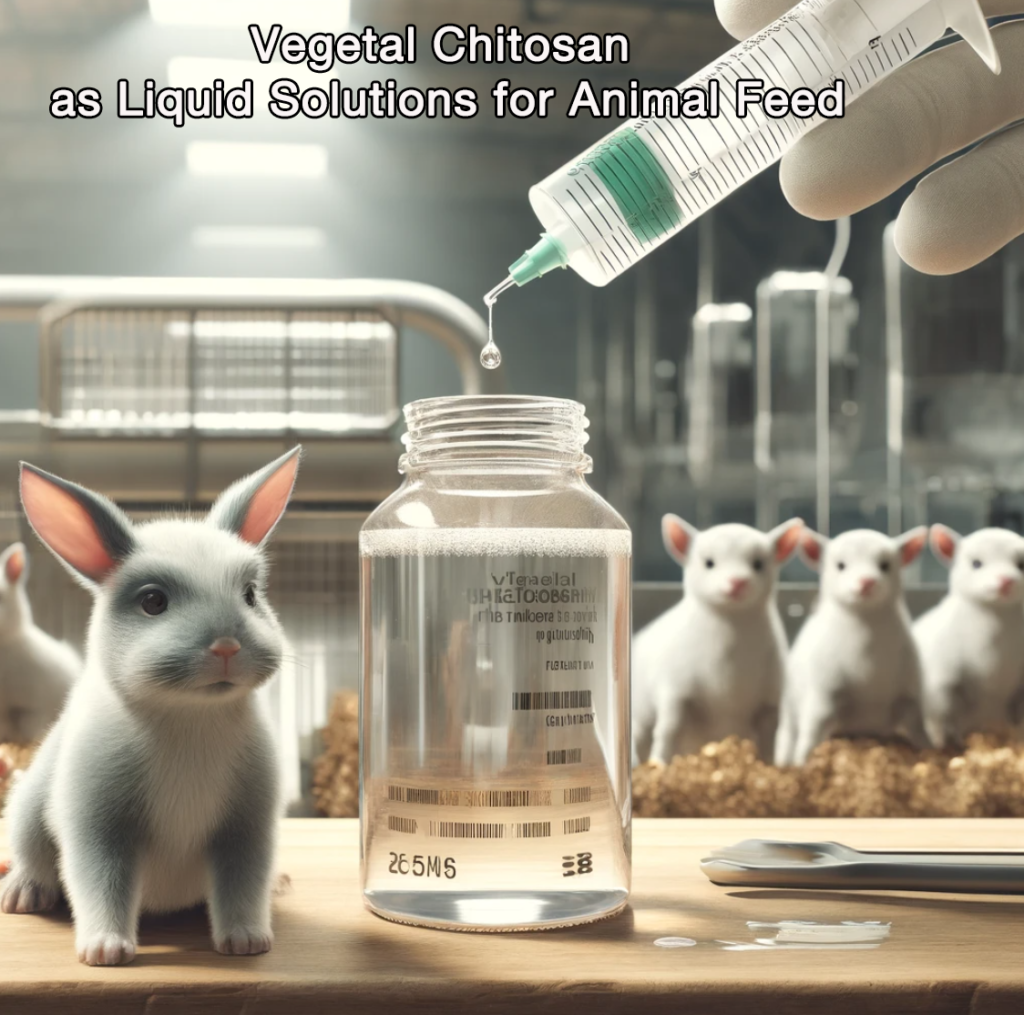
- Coated Forms: Chitosan can be coated onto feed pellets to control the release of active compounds or to protect the integrity of the chitosan in the digestive tract.
- Addition Ratio: Usually around 0.5% to 1%, depending on the coating efficiency and the target release profile.
- Suitable Chitosan Types: Acid-soluble chitosan with a viscosity range of 100-500cps or 500-1000cps is often used for coating applications. Chitosan oligosaccharide may also be suitable.
- Corresponding Applications:
- Controlled release formulations for targeted health benefits in livestock and aquaculture.
- Protection of active ingredients during feed processing and storage.
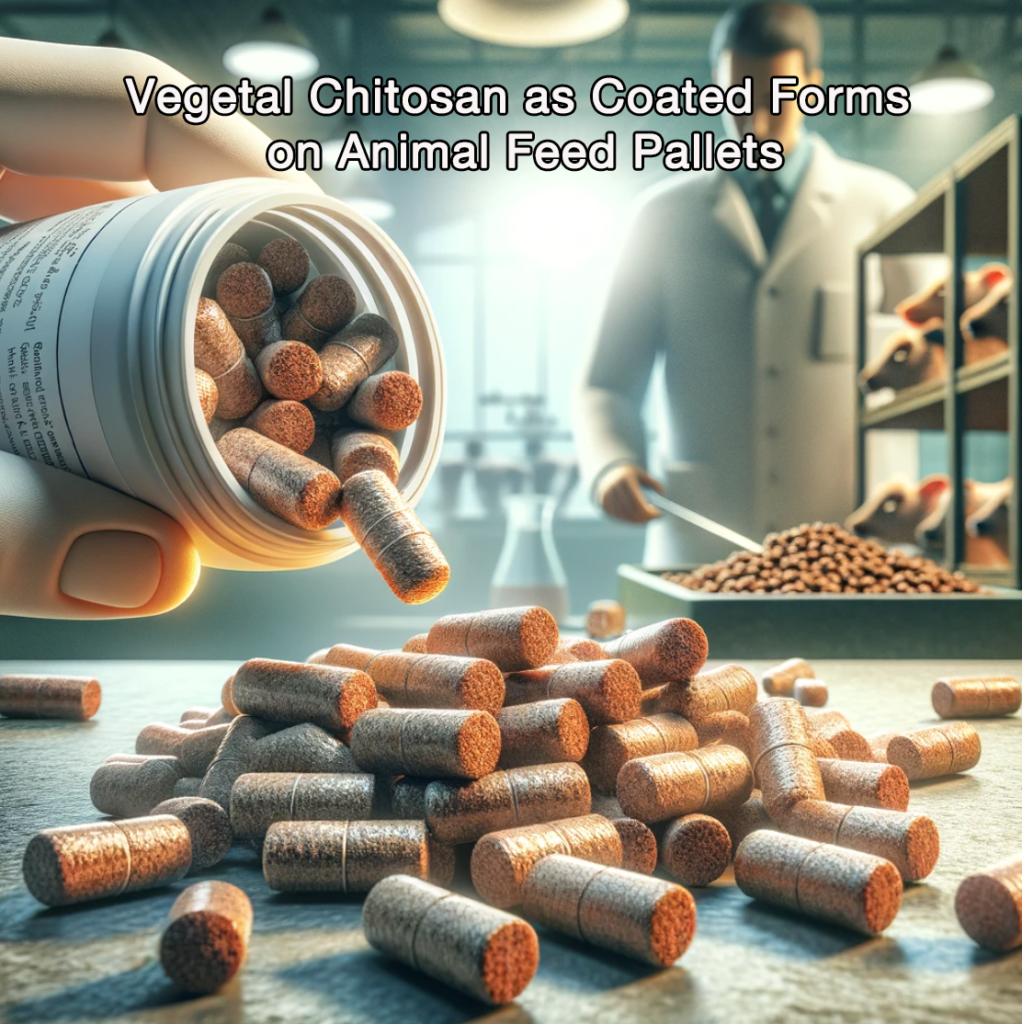
- Gel: In some applications, chitosan may be used in a gel form, particularly useful for specialized dietary needs or in veterinary health products.
- Addition Ratio: Less common, but typically used at higher concentrations, such as 1% to 10% in specific targeted applications.
- Suitable Chitosan Types: Acid-soluble chitosan with a viscosity range of 100-500cps or 500-1000cps is commonly used for gel formulations. Chitosan hydrochloride may also be suitable.
- Corresponding Applications:
- Veterinary health products.
- Specialized dietary supplements for specific animal health needs.
- Controlled release formulations for prolonged effects.
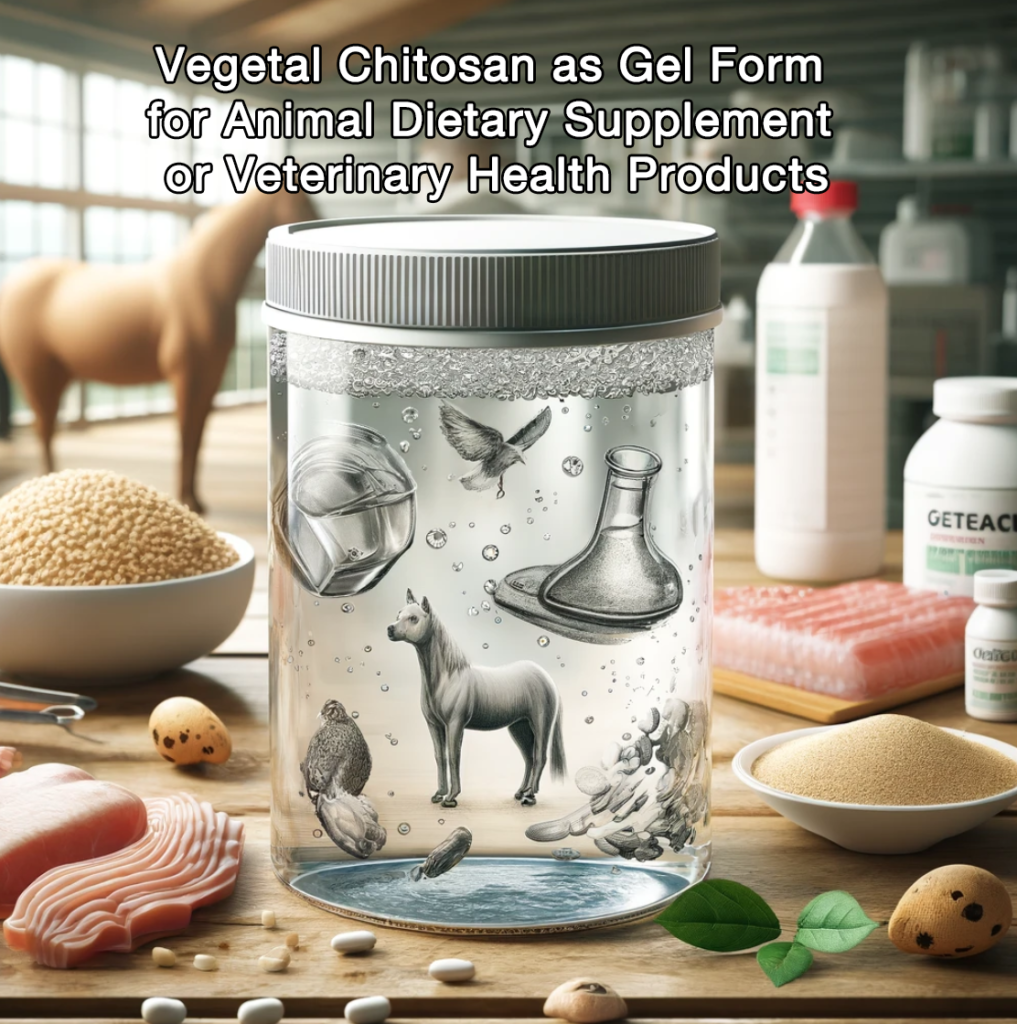
Each of these forms allows for different methods of application and dosage control, making chitosan a flexible and effective additive for various animal feeding regimes.
The specific addition ratios and applications can depend on the results desired, the specific type of chitosan used (e.g., molecular weight, degree of deacetylation), and the nutritional requirements of the particular species of animal. It’s also important to follow local regulations and guidelines regarding the use of feed additives to ensure safety and efficacy.
Moreover, these recommendations are based on the properties of each type of chitosan and their typical applications in animal feed formulations. It’s important to consider specific requirements and consult with experts to determine the most suitable chitosan type for a particular application.
6. What is the flowchart of vegetal chitosan processing?
The production process of plant chitosan is mainly obtained by extracting raw materials (mushrooms, Aspergillus niger), deproteinizing with dilute acid or alkali, deacetylating, drying, etc.
Here is a simplified flowchart of the production process of vegetal chitosan for your reference.
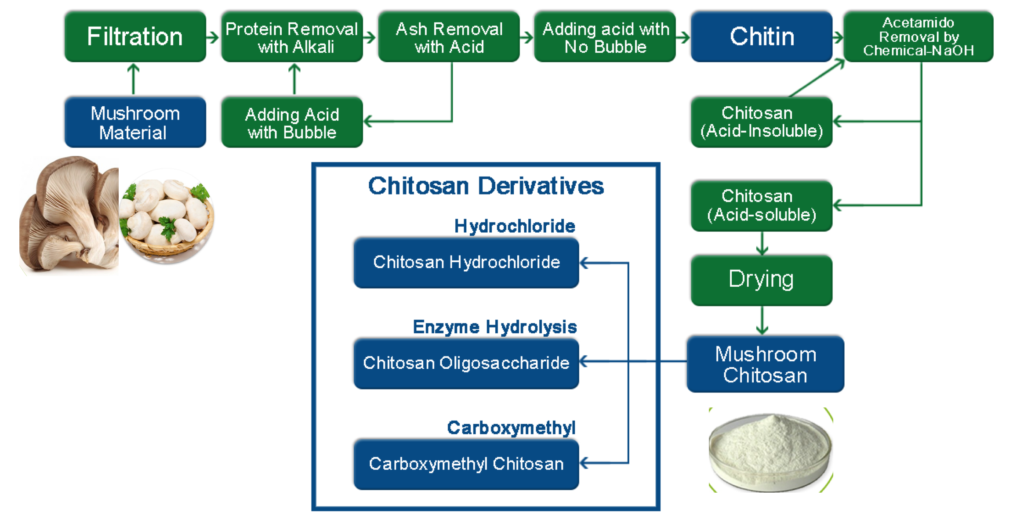
The flowchart of mushroom chitosan illustrates the process of producing chitosan and its derivatives from mushroom material. Here’s a summary of the key content:
- Starting Material: The process begins with mushroom material as the source.
- Filtration: The mushroom material undergoes a filtration process.
- Protein Removal: Proteins are then removed from the filtered material using an alkali solution.
- Ash Removal: Ash content is subsequently removed with acid.
- Chitin Extraction:
- Acid is added without bubbles to proceed to the next stage.
- Chitin is extracted, which is not soluble in acid.
- An acetylation step removes the acetyl groups from the chitin using sodium hydroxide (NaOH), converting it into chitosan, which is soluble in acid.
- Drying: The acid-soluble chitosan is then dried to produce the final mushroom chitosan product, showcased as a white powder.
- Chitosan Derivatives: Parallel to the drying process, there is a branch leading to the production of various chitosan derivatives:
- Chitosan Hydrochloride: Chitosan converted into its hydrochloride form.
- Enzyme Hydrolysis: Produces chitosan oligosaccharide through enzymatic hydrolysis.
- Carboxymethyl Chitosan: Derived through the carboxymethylation of chitosan.
The flowchart depicts a methodical approach to converting mushroom material into various forms of chitosan, focusing on the purification and chemical modification steps necessary to achieve different chitosan-based products for use in various applications.
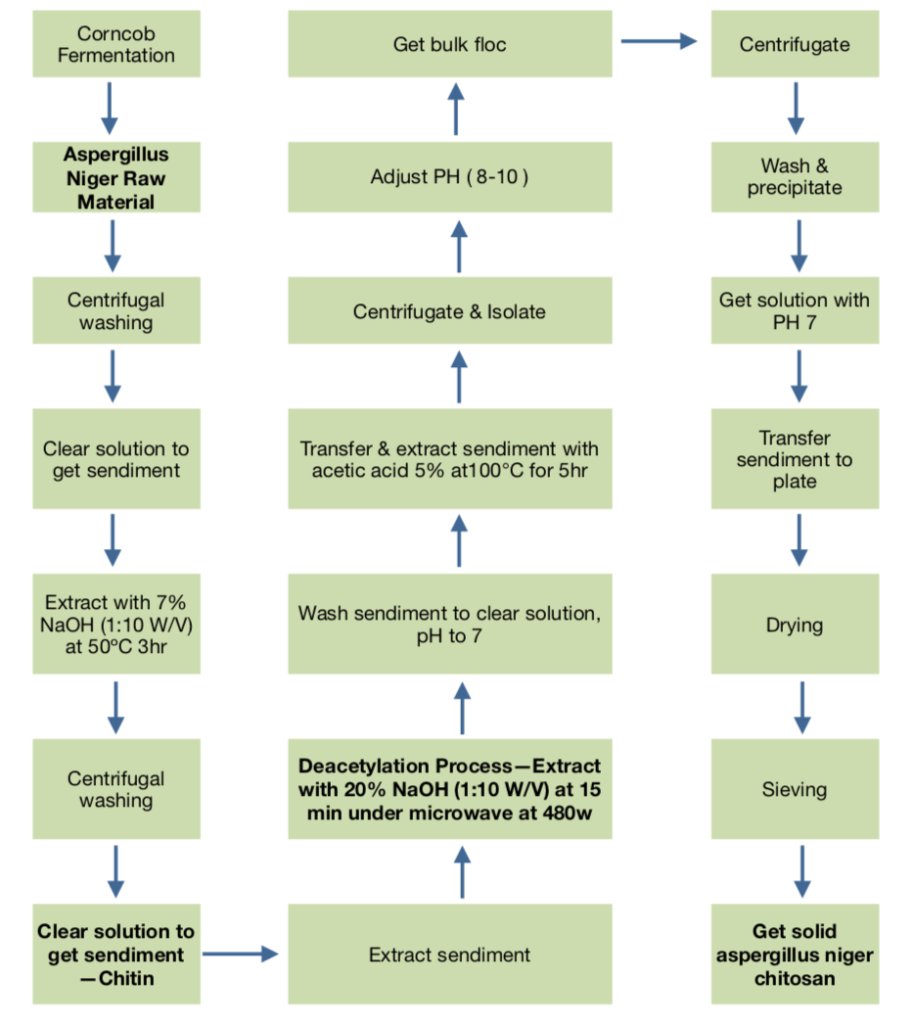
The flowchart of aspergillus niger chitosan outlines the process for extracting chitosan from Aspergillus niger, a type of fungus. Here’s a step-by-step summary of the key points:
- Starting Material: Aspergillus niger is cultured through a fermentation process using corn.
- Extraction:
- The fungal biomass undergoes a bulk flocculation.
- This is followed by centrifugation to separate the components.
- The pH of the resulting material is adjusted to alkaline conditions (pH 8-10).
- Another round of centrifugation and isolation occurs.
- The pH is adjusted back to neutral (pH 7), and the sediment is washed and precipitated.
- The sediment is then extracted with 5% acetic acid at 100°C for five hours to get the clear solution.
- It is washed again to achieve a clear solution with a neutral pH.
- Chitin Production:
- The clear solution is treated with 7% sodium hydroxide (NaOH) at a ratio of 1:10 (W/V) at 50°C for three hours.
- Centrifugal washing follows, resulting in the production of chitin as a clear solution to get the sediment.
- Deacetylation:
- The sediment undergoes the deacetylation process. It’s treated with 20% NaOH at a ratio of 1:10 (W/V) and heated in a microwave at 480W for 15 minutes.
- This step is crucial to convert chitin into chitosan by removing acetyl groups.
- Final Steps:
- The final sediment, which is now deacetylated chitin or chitosan, is extracted.
- It undergoes drying, followed by sieving to achieve the desired particle size.
- End Product: The final product is solid Aspergillus niger chitosan.
This process includes several steps involving pH adjustment, centrifugation, chemical treatments, and heating, which are critical to ensuring the purity and quality of the chitosan extracted from Aspergillus niger.
7. In summary for vegetal chitosan used in animal feed?
Vegetal chitosan, derived from mushrooms and Aspergillus niger, stands as a cornerstone in animal nutrition, offering a comprehensive array of benefits.
Serving as a natural enhancer of gut health, it fosters the proliferation of beneficial gut bacteria while inhibiting the growth of harmful pathogens, thereby facilitating optimal nutrient absorption and fortifying the animal’s immune defenses.
Its versatility is underscored by its proficiency in toxin binding, effectively neutralizing toxins and heavy metals in the digestive tract, thereby safeguarding animal health.

Moreover, vegetal chitosan’s inherent antimicrobial properties contribute to maintaining a balanced microbial ecosystem in the gut, further augmenting the animal’s overall well-being.
The efficacy of vegetal chitosan is further amplified by its availability in various forms tailored to different applications in animal feed.
Whether in powder, pellet, liquid solution, or gel form, vegetal chitosan offers flexibility in incorporation into feeds, enabling precise dosage control and targeted delivery of its beneficial effects.
Each form offers unique advantages, from improved feed efficiency and growth promotion to enhanced disease resistance and immune modulation.
Through its diverse forms and multifaceted benefits, vegetal chitosan emerges as an indispensable component in promoting animal health and productivity across a spectrum of livestock and aquaculture operations.

